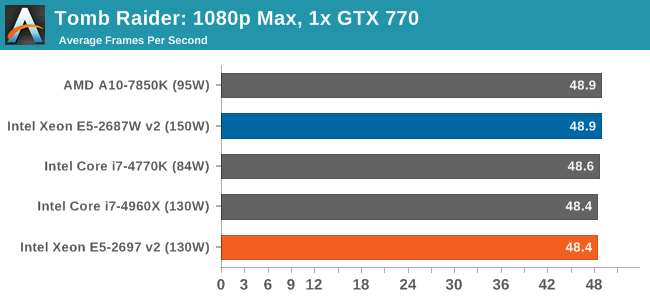Intel Xeon E5-2697 v2 and Xeon E5-2687W v2 Review: 12 and 8 Cores
by Ian Cutress on March 17, 2014 11:59 AM EST- Posted in
- CPUs
- Intel
- Xeon
- Enterprise
For our gaming benchmarks we brought in the MSI X79A-GD45 for some three-way GPU action, as the original GIGABYTE motherboard is limited beyond two GPUs. For the Xeons in our tests, the PCIe arrangement gave x16 in single GPU mode, x16/x16 in dual GPU mode and x16/x16/x8 in tri-GPU mode.
F1 2013
First up is F1 2013 by Codemasters. I am a big Formula 1 fan in my spare time, and nothing makes me happier than carving up the field in a Caterham, waving to the Red Bulls as I drive by (because I play on easy and take shortcuts). F1 2013 uses the EGO Engine, and like other Codemasters games ends up being very playable on old hardware quite easily. In order to beef up the benchmark a bit, we devised the following scenario for the benchmark mode: one lap of Spa-Francorchamps in the heavy wet, the benchmark follows Jenson Button in the McLaren who starts on the grid in 22nd place, with the field made up of 11 Williams cars, 5 Marussia and 5 Caterham in that order. This puts emphasis on the CPU to handle the AI in the wet, and allows for a good amount of overtaking during the automated benchmark. We test at 1920x1080 on Ultra graphical settings for a single GPU, as using multiple GPUs seems to have no scaling effect.

| F1 2013, 1080p Max | ||
| NVIDIA | AMD | |
| Average Frame Rates |
|
|
| Minimum Frame Rates |
|
|
While the higher frequency of the E5-2687W v2 puts it ahead of the 12-core Xeon, in each of our data points, except 3x HD7970, the Core i7-4960X gets the better frame rates.
Bioshock Infinite
Bioshock Infinite was Zero Punctuation’s Game of the Year for 2013, uses the Unreal Engine 3, and is designed to scale with both cores and graphical prowess. We test the benchmark using the Adrenaline benchmark tool and the Xtreme (1920x1080, Maximum) performance setting, noting down the average frame rates and the minimum frame rates.

| Bioshock Infinite, 1080p Max | ||
| NVIDIA | AMD | |
| Average Frame Rates |
|
|
| Minimum Frame Rates |
|
|
Again, the 8-core higher frequency Xeon is faster than the 12-core Xeon in most of our tests, however the i7-4960X beats them most of the time. For certain arrangements, such as 2x HD7970, the Xeons lose slightly to the i7-4770K, most likely due to CPU IPC. However as the difference is only a couple of frames per second out of 130, this should not make much difference.
Tomb Raider
The next benchmark in our test is Tomb Raider. Tomb Raider is an AMD optimized game, lauded for its use of TressFX creating dynamic hair to increase the immersion in game. Tomb Raider uses a modified version of the Crystal Engine, and enjoys raw horsepower. We test the benchmark using the Adrenaline benchmark tool and the Xtreme (1920x1080, Maximum) performance setting, noting down the average frame rates and the minimum frame rates.

| Tomb Raider, 1080p Max | ||
| NVIDIA | AMD | |
| Average Frame Rates |
|
|
| Minimum Frame Rates |
|
|
In all the Tomb Raider tests, all the CPUs perform similarly, making Tomb Raider a seemingly agnostic test to CPU power.













71 Comments
View All Comments
Ian Cutress - Tuesday, March 18, 2014 - link
I need to spend some time to organise this with my new 2014 benchmark setup. That and I've never used bench to add data before. But I will be putting some data in there for everyone :)Maxal - Tuesday, March 18, 2014 - link
There is one sad thing - disappearance of 2C/4T high clock speed CPUs, as Oracle Enterprise Edition charges by cores.....and sometimes you need just small installation but with EE features...Rick83 - Tuesday, March 18, 2014 - link
Wouldn't L3/thread be a more useful metric than L3/core in the big table?HT will only really work after all, if both threads are in cache, and if you can get a CPU with HT and one without, as is the case with the Xeons, you'd get the one without because you are running more concurrent threads. That means that under optimum conditions, you have 2 threads per core that are active, and thus 2x#cores threads that need to be in the data caches.
HalloweenJack - Tuesday, March 18, 2014 - link
holy shit anandtech you really have gone to the dogs - comparing a £2000 cpu against a £100 apu and saying its better..... and really? wheres the AMD AM3+ cpu`s? 8350 or 9590? seriouslyIan Cutress - Tuesday, March 18, 2014 - link
Let's see. I'm not comparing it against a £100 APU, I'm comparing it against the $1000 Core i7-4960X to see the difference. We're using a new set of benchmarks for 2014, which I have already run on the APU so I include them here as a point of reference for AMD's new highest performance line. It is interesting to see where the APU and Xeon line up in the benchmarks to show the difference (if any). AMD's old high end line has stagnated - I have not tested those CPUs in our new 2014 set of benchmarks. There have been no new AM3+ platforms or CPUs this year, or almost all of last year. Testing these two CPUs properly took the best part of three weeks, including all the other work such as news, motherboard reviews, Mobile World Congress coverage, meetings, extra testing, bug fixing, conversing with engineers on how to solve issues. Sure, let's just stop all that and pull out an old system to test. If I had the time I really would, but I was able to get these processors from GIGABYTE, not Intel, for a limited time. I have many other projects (memory scaling, Gaming CPU) that would take priority if I had time.AKA I think you missed the point of the article. If you have a magical portal to Narnia, I'd happily test until I was blue in the face and go as far back to old Athlon s939 CPUs. But the world moves faster than that.
deadrats - Tuesday, March 18, 2014 - link
any chance of updating this article with some x265 and/or Divx265 benchmarks? hevc is much more processor intensive and threading friendly, so these encoders may be perfect for showing a greater separation between the various core configurations.Ian Cutress - Tuesday, March 18, 2014 - link
If you have an encoder in mind drop me an email. Click my name at the top of the article.bobbozzo - Tuesday, March 18, 2014 - link
Hi,1. please change the charts' headings on the first page to say 'Cores/Threads' instead of 'Cores'.
2. it wasn't clear on the first page that this is talking about workstation CPUs.
3. "Intel can push core counts, frequency and thus price much higher than in the consumer space"
I would have said core counts and cache...
Don't the consumer parts have the highest clocks (before overclocking)?
Thanks!
bobbozzo - Tuesday, March 18, 2014 - link
"it wasn't clear on the first page that this is talking about workstation CPUs."As opposed to servers.
Ian Cutress - Tuesday, March 18, 2014 - link
1) I had it that way originally but it broke the table layout due to being too wide. I made a compromise and hoped people would follow the table in good faith.2) Generally Xeon in the name means anything Workstation and above. People use Xeons for a wide variety of uses - high end for workstaitons, or low end for servers, or vice versa.
3) Individual core counts maybe, but when looking at 8c or 12c chips in the same power bracket, the frequency is still being pushed to more stringent requirements (thus lower yields/bin counts) vs. voltages. Then again, the E3-1290 does go to 4.0 GHz anyway, so in terms of absolute frequencies you can say (some) Xeons at least match the consumer parts.